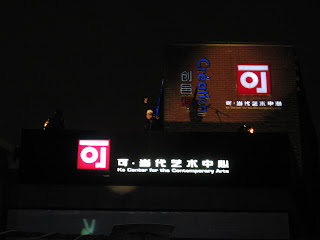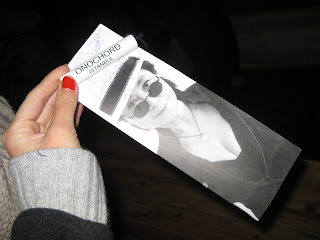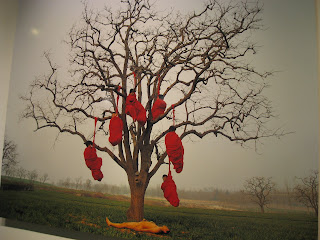http://www.prospect-magazine.co.uk/article_details.php?id=10474A second tulipmania
The bubble in contemporary art is about to pop. It has exhibited all
the classic features of the South Sea bubble of 1720 or the tulip
madness of the 1630s. It has been the bubble of bubbles—balancing
precariously on top of other now-burst bubbles in credit, housing and
commodities—and inflating more dramatically than all of them. While
British house prices took six years to double at the start of this
century, contemporary art managed it in just one, 2006-07. (Over the
same period, old masters went up by just 7.6 per cent and British
17th to 19th century watercolours actually lost value.) Contemporary
art in the emerging economies did even better. The value of its sales
in China increased by 983 per cent in one year (2005-06). In Russia
they rose 2,365 per cent in five years (2000-05), while its stock
market increased by "only" about 300 per cent.
Even these numbers understate the incredible tulip-like increases in
the value of the hottest artists. The Chinese painter Zhang Xiaogang
saw his work appreciate 6,000 times, from $1,000 to $6m (1999-2008);
work by the American artist Richard Prince went up 60 to 80 times
(2003-2008). The German painter Anselm Reyle was unknown in 2003; you
could have picked up one of his stripe paintings for €14,000. Now he
has a studio with 60 assistants turning them out for about €200,000
each. Any figures for the whole contemporary art market are
guesswork, though Christie's chief executive, Ed Dolman, recently
estimated that it had grown in value from $4bn a year to somewhere
between $20-30bn in the past eight years.
But this bubble is now deflating. Sotheby's share price has lost
three quarters of its value over the past year, sinking from its peak
of $57 in October 2007 to $9 in early November—close to its 1980s low
of $8. The latest round of contemporary art auctions in London has
gone badly. In October, the Phillips de Pury sale made only £5m—a
quarter of the minimum estimate; at Christie's almost half the lots
didn't sell; and an air of denial hung over the Frieze art fair like
a fog. Upmarket dealers Matthew Marks and Iwan Wirth claimed to have
clinched many big deals, but the reality was surely different. A
leading New York gallerist was said to have sold very little and a
well-known German dealer not a single work.
Some dealers have blamed the poor quality of the works in the London
sales. "Just wait for New York in mid-November," one said, "and
you'll see the art market is still doing well." But New York has been
no better. This should have come as no real surprise. If you consider
the market as a purely financial enterprise, rather than one in which
aesthetic quality has any bearing, then the boom in contemporary art
has the hallmarks of a classic investment bubble.
***
In his book, Manias, Panics, and Crashes, Charles Kindleberger
observed that manias typically start with a "displacement" that
excites speculative interest. It may come from a new object of
investment or from the increased profitability of existing
investments. It is followed by positive feedback as rising prices
encourage less experienced investors to enter the market. Then, as
the mania gets a grip, speculation becomes more diffuse and spreads
to other types of asset. Fresh assets are created at an ever faster
rate to take advantage of the euphoria and investors try to increase
their gains by borrowing to buy assets or using derivatives. Credit
ultimately becomes overextended, swindling and fraud proliferate, and
the mania ends in panic as investors seek to liquidate their positions.
The art market has adhered spookily to Kindleberger's model. By 2004
it was clear that a boom in contemporary art was well underway ("The
price of art," Ben Lewis, Prospect, October 2004.) At the Armory
show, New York's trendsetting contemporary art fair, dealers sold
$43m worth of art in four days, nearly twice as much as the previous
year. There were huge price rises at auction, too. A 1996 sculpture
of a stuffed horse hanging from a ceiling, Ballad of Trotsky, by the
fashionable and witty Italian artist Maurizio Cattelan, sold for $2m
at auction in May 2002. It had increased in value tenfold in two
years. Gerhard Richter's paintings quadrupled in value between 2000
and 2004. Even then, buyers were paying $1m to $3m for a work by
Hirst, Warhol, Basquiat or Koons. Those sums now seem quaint—last
year a Koons went for $23m, a Hirst for $20m and a Basquiat for $15m.
The moment of "displacement" was driven by the emergence of a global
class of the new rich. These billionaires, who had probably never
drawn more than stick figures with a biro, were drawn to artistic
creation. They wanted to collect contemporary art, partly because
they liked it, partly because it was a status symbol, partly because
most of the good old master works were in museums, and partly because
it seemed to be a solid investment.
The way was led by people like Charles Saatchi and the Miami property
magnates, the Rubells. Saatchi laid down a blueprint in the late
1990s that others have tried to copy—he bought the work of young
artists, established a museum in which to display it or lent it to
public museums, and used the media interest that such shows attracted
(by virtue of the outlandish works involved and the association of
celebrities) to sell on part of the collection at auction at greatly
inflated prices. Some of the proceeds would then be reinvested in the
work of other new discoveries. Saatchi's famous 1997 show,
"Sensation," demonstrated that this "specullecting" was a great way
to make a splash as an arbiter of taste. Others took an earthier view
of the collectors' instinct. Amy Capellazzo, the co-head of
Christie's contemporary art department, observed in 2007: "After you
have a fourth home and a G5 jet, what else is there?"
According to Forbes, the number of billionaires in the world has been
growing by 20 per cent a year since 2000. There were 476 in 2003, now
there are 1,125. As they began to collect contemporary art, prices
started to rise. New fairs, such as Art Basel Miami Beach and Frieze
in London, were a success. Newspapers ran stories that promoted the
boom. Advertising from rich galleries and art businesses and the
untouchable sanctity of "art" deterred criticism. The public flocked
to art galleries. The Tate Modern had 5.2m visitors in 2007, making
it the most popular museum of modern art in the world.
This boom was different from the one in the 1980s. Then, it had
depended on Japanese property speculators buying with credit secured
against inflated real estate values. This time the buyers were more
widely spread and paid with cash, not promissory notes. Art had
become a new asset class—akin to shares or oil. In 2007, Tobias
Meyer, Sotheby's head of contemporary art, effused: "The best art is
the most expensive because the market is so smart."
***
Contemporary art turned out to be an ideal vehicle for speculative
euphoria. The market is almost entirely free from state interference.
Governments have had little interest in regulating the trinkets and
playthings of the super-rich. Art works are a uniquely portable and
confidential form of wealth. Whereas all property purchases have to
be publicly registered, buying art is a private activity. And unlike
old masters, which are often linked by history to specific places,
contemporary art knows no frontiers.
By 2006, the bubble was well into Kindleberger's second phase:
diffusion. Rising prices were sucking in new investors. In the first
half of 2006, 454 works exceeded $1m at auction, up from 130 in the
same period of 2003 as Asian billionaires joined European buyers. In
Britain, there was the Banksy market, a kind of contemporary art
lite, for people with thousands rather than millions to spend. Images
that would once have never made it past a T-shirt, mug or wall, were
now bought and sold as limited edition prints and stencils on canvas.
In 2003, one of the 50 spoofy Kate Moss prints by Banksy in the style
of Warhol's Marilyn could have been yours for £1,500. In February
this year one sold for £96,000 at Bonhams. (Now the price is half that.)
Established collectors dropped out or were nudged sideways towards
lesser known artists by the activities of the new rich. The titans of
the showrooms included hedge fund bosses such as Steve Cohen, whose
SAC fund was responsible for about 3 per cent of daily trading on the
New York stock exchange. Other big buyers were Asian billionaires,
like Joseph Lau from Hong Kong, oil tycoons and the oligarchs with
their huge stakes in metal extraction and banks. The Georgian Boris
Ivanishvili spent $95m on Picasso's Dora Maar au Chat—a work of art
that he still hasn't unpacked. When it was flown back to Tbilisi, the
airport was closed down and the army turned out to ensure the work's
transfer to a secure warehouse. These financial investors didn't
simply shove their wealth into contemporary art, they imported the
strategies of financial investment into art collecting. Alien
phrases, such as "price discovery," were heard in galleries and
auction houses.
Investors became beady-eyed about tracking which artists leading
museums considered important and followed the prices of their works
on Artnet's database like stock market indices.
Indeed, the new art market bore about as much resemblance to
traditional collecting as the modern financial system of credit
default swaps and mortgage-backed securities did to traditional
banking. The correlation between value and rarity in art went out of
the window. Paintings by old masters such as Vermeer and Rembrandt
hold their value because there are a finite number in the world. This
is both a guarantor of value and limits the extent of any speculative
activity. But, as Kindleberger has shown, it is a condition of a
speculative mania that new "assets" be manufactured to meet raging
demand—so the recent bubble has focused on the works of living
artists such as Hirst, Koons, Prince and Murakami. They, and other
stars, have produced scores of very similar works in series, like the
slashed canvases of the Italian conceptual artist Lucio Fontana,
Warhol's screenprints or Hirst's spins and spots.
More and more of such work has been churned out by cookie-cutter
artists without regard to originality or aesthetic merit. Economist
and historian of financial crashes, Edward Chancellor, observed
recently: "Most contemporary art is inherently worthless. It is not
like Titian and other old masters of which there are few and whose
value will not fall away. It's like subprime CDOs."
At the peak of the South Sea bubble in 1720, a series of stock
promoters emerged touting the shares of "bubble companies" that aimed
to take advantage of high share prices. We laugh now at the
prospectuses of these tawdry ventures—not least the one proposing to
carry out "an undertaking of great advantage, but nobody to know what
it is." As the art bubble has neared its peak, the great art-
entrepreneurs such as Hirst, Banksy, Prince or the Chinese artists,
Xiaogang and Yue Minjun, seem increasingly like these 18th-century
promoters. Not only have they pumped out identical works, but they
have also sought to capture more of the value for themselves,
bypassing the gallerists with whom they are obliged to share 50 per
cent of sales and selling direct out of the studio or placing new
works straight into auction. Five years ago it was unknown for a work
of art that was only one or two years old to be sold at auction. Now
this is common—the best example being the Hirst sale of over 200 new
works at Sotheby's in September.
***
The final phase of any bubble is characterised by overextended credit
as investors use leverage to magnify their gains. It is also the peak
of what JK Galbraith referred to as "the bezzle"—the amount of money
siphoned from the system through outright corruption and fraud. The
opacity of the art market makes it hard to know how exposed it is to
the credit crunch. But the auction houses are weighed down by debt
from guarantees—the prices that they have guaranteed to pay the
sellers of works of art in their auctions (which they extend to
persuade sellers to sell works through them). Auction house Phillips
de Pury was rescued by a takeover by the Russian luxury goods company
Mercury. In November, Sotheby's announced it had around $250m of debt
in the form of guarantees to the end of the year. It had already lost
$47m on work that hadn't sold and has since stopped giving further
guarantees. Sotheby's has borrowed $250m to "ensure additional
liquidity." Christie's has also taken out a loan and in October
suspended offering any further credit terms to its customers,
according to an auction house executive.
The mania for collecting contemporary art has become ever more
intense in the past 12 months—in the first half of this year, new
auction records were set for almost 1,000 artists. But the suspicion
is that dealers and collectors with interests in particular artists
may have been "bidding up" prices at auction and acquiring works. If
so, they may be holding large inventories of overvalued work,
financed by increasingly expensive debt. At the Damien Hirst auction
at Sotheby's, his London dealer, Jay Jopling, bid on an astonishing
44 per cent of the lots in the evening sale, and both he and Hirst's
US dealer, Larry Gagosian, bid on two lots after long pauses in the
bidding. One cannot know if Jopling was maintaining Hirst's prices at
his own expense or bidding for clients.
The lack of transparency often makes it hard to know who is doing
what to whom. On 30th August last year, Hirst's business manager
Frank Dunphy and Jopling declared publicly that they had sold his
diamond-encrusted skull For the Love of God for "the full asking
price of £50m"—the highest price ever paid for a work by a living
artist. But just over a year later, Dunphy told Time magazine that
he, Jopling and Hirst owned "a controlling stake" in the skull. A
controlling stake is one that exceeds 50 per cent (and could be
anything up to 100 per cent). In the stock market, a transaction of
this kind would require disclosure to avoid the creation of a "false
market." But as we have seen the art market is unregulated.
As the credit crunch struck, it became evident that American and
Europeans would be buying less art. But that, we were told, did not
matter because a wave of new buyers from Russia and the middle east
would take their place, their wealth buoyed by high commodity prices.
Sotheby's press releases said that every year 20 per cent of their
clients were new and, for the Hirst auction, 22 per cent of the
buyers were new clients. New records were set by these art virgins—
Roman Abramovich paid $86m for a Francis Bacon in July 2008 and the
Qatari royal family, previously known for collecting Islamic art,
bought the Rockefeller Rothko for $73m.
The propaganda of the art entrepreneurs has also reached a final
level of absurdity. We were told that the decline of paper assets
would lead to "a flight of capital into art." The art market, Tobias
Meyer of Sotheby's said in June, is a one-way street: "For the first
time since 1914 we are in a non-cyclical market."
Over the winter of 1636, the tulip mania reached its peak. One kind
of bulb sold for 900 guilders (three times the price of a small town
house), up from 95 a year before. The peak prices of Dutch tulips
were achieved when the bulbs were snug in the ground, and were based
on futures contracts—a form of leverage that allowed investors to
place an enormous price on a bulb without actually laying down the
cash. On 3rd February 1637, the tulip market crashed. There was no
particular reason for the panic—except that spring was nearing and,
on its arrival, the bulbs would be dug up, cash settlement sought for
futures and the game would be up.
We have surely reached the same point in the world of contemporary
art. One of the emotions that has driven its boom is the narcissistic
belief of the rich in the greatness of the age in which they are
living. They thought they were buying masterpieces. But like the
Dutch merchants and their tulips, the obsession of the new rich with
contemporary art is likely to be remembered as the epitome of the
vanity and folly of the age. The bulbs are still in the ground but
the spades are poised.



































